The Simpsons and Hollywood: Revisiting Our Favourite Classics
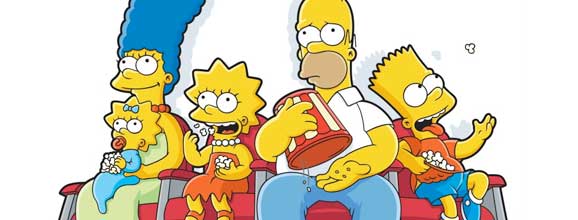
The Simpsons is more than a simply entertaining cartoon made to amuse teenagers. It is far more rich, and builds one of the greatest parody of American society (and not only American). It certainly is one of the most popular adult cartoon, with a total of 25 seasons and a 2009 Guinness World record as the longest running American sitcom. Beyond the first impression of clumsy, heavy-handed comedy, one discovers that The Simpsons offers a wider palette of intercultural references which sharpen its social critique. It isn’t just bold mockery, and it pays tribute to many artists and works. Of course, its primary intention is to be satirical; but in doing so, and through its important diffusion worldwide, the show transmits the world’s cultural heritage. One simply cannot grasp the meaning of an episode without taking a closer look at its many political and cultural allusions. And if you can’t understand the reference, then you find it harder to laugh.
The sitcom alludes to several popular events and works, from music to politics, urban legends to historical affairs; but one of its main source of inspiration is the cinema. Groening obtained a degree in Philosophy and Cinema, and in his early career, he experienced life in Hollywood. In fact, the years he spent in L.A inspired his first comic book, Life in Hell. It became successful almost immediately, and marked the beginning of Groening’s critique of Hollywood. Most episodes are somehow linked to film, whether they involve famous actors/filmmakers or reproduce a well-known scene, and despite their comic purpose, these parodies pay sincere tribute to cinema.
So to all of us film-lovers, and to those who are not yet convinced by the show, here are some of the best cinematic moments, pastiches and caricatures, revisited by The Simpsons.
Stanley Kubrick
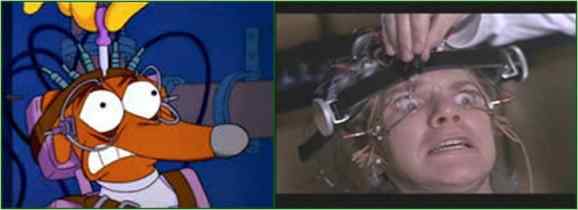
A certain amount of episodes directly refer to Stanley Kubrick’s work and reproduce some of the most popular scenes of his filmography. Kubrick was famous for his meticulous attention to details, his choice of ironic music in contrast with the images on-screen and his portrayal of dehumanized men. The sitcom preserves the director’s stylistic characteristics, and in the same way that he wanted to denounce human madness, The Simpsons points out overconsumption, media monopoly, war propaganda and nuclear rule.
In Deep Space Homer (Seas 5, Ep15), Homer goes to the moon, and while the capsule defies gravity, he opens a bag of potato chips. They spread everywhere, menacing to clog the instruments on board. Homer floats after the crisps, swaying and whirling while The Blue Danube plays in the background, eating one chip after the other in a superb ballet, directly taken from 2001: A Space Odyssey. The creators treat Homer’s insatiable appetite in the same “poetic” way as Kubrick displays his fascination for space technology; but here, the banal crisps replace the grandiose machines, which makes us laugh at Homer’s craving for junk food. Thus the audience reflects on the effect of massive consumption and malnutrition. In the same episode, the famous cut from the monkey’s bone to the spacecraft is replaced with a pen in the air cut to a FOX satellite, symbol of TV domination. It ends with the famous foetus image, Homer being the embryo, looking upon us. In Lisa’s Pony (S3Ep8), ‘The Dawn of Man’ sequence is faithfully replicated, just as Brother, Can You Spare Two Dimes? (S3Ep24) reproduces the psychedelic voyage of Dave Bowman/Homer when he approaches Jupiter.
Kubrick’s work usually deals with man’s violent impulse against his peers, and raises critical issues about the power of psychological conditioning and humans’ overuse of destructive forces. This need to exteriorise violence is further explored through The Simpsons ‘s appropriations of popular Kubrick scenes, exaggerated for comic purposes. In Dog of Death (S3Ep19), Mr. Burns wants to turn the Simpsons’ dog, Santa’s Little Helper, into a fierce guard dog, and ends up attaching him to a chair maintaining his eyes open while he watches films of dog abuse. Through this direct reference to A Clockwork’s Orange, Groening condemns animal abuse. Bart the Colonel (S1Ep5) copies shots from Full Metal Jacket, but here the it is the children who perpetuate violence, subject to military indoctrination.
 In Homer the Vigilante (S5Ep11), Homer rides an enormous nuclear bomb like a rodeo, just as T.J King does in Dr. Strangelove, and a few episodes dealing with nuclear menaces (like Sideshow’s Bob Last Gleaming, S7Ep9) reconstitute the Pentagon’s secret reunion room. And let’s not forget the amazing remake of The Shinning in Treehouse of Horror V (S6Ep6) where every little detail is thoroughly constructed as an echo of the original film, from the labyrinth-like motif on the carpet to the dead twin sisters. Homer incarnates Jack Torrance and replicates with exactitude Nicholson’s facial mimics, even as a cartoon. What we gain from this episode is crucial in the understanding of Homer’s character: no beer and no TV makes Homer go crazy! Here, Groening condemns the destructive effects of media and alcohol on the human mind, both symbols of an over-consumerist society that literally brainwashes people.
In Homer the Vigilante (S5Ep11), Homer rides an enormous nuclear bomb like a rodeo, just as T.J King does in Dr. Strangelove, and a few episodes dealing with nuclear menaces (like Sideshow’s Bob Last Gleaming, S7Ep9) reconstitute the Pentagon’s secret reunion room. And let’s not forget the amazing remake of The Shinning in Treehouse of Horror V (S6Ep6) where every little detail is thoroughly constructed as an echo of the original film, from the labyrinth-like motif on the carpet to the dead twin sisters. Homer incarnates Jack Torrance and replicates with exactitude Nicholson’s facial mimics, even as a cartoon. What we gain from this episode is crucial in the understanding of Homer’s character: no beer and no TV makes Homer go crazy! Here, Groening condemns the destructive effects of media and alcohol on the human mind, both symbols of an over-consumerist society that literally brainwashes people.
Alfred Hitchcock
Hitch the Master of Suspense is a key inspiration for Matt Groening, and several episodes honour his work. For instance, Bart of Darkness (S6Ep1) is a direct reprise of Rear Window. In this episode, Bart breaks his leg and, bored, stalks his neighbours with a telescope. He suspects Flanders of murdering his wife and sends Lisa (a parallel to Lisa Fremont aka Grace Kelly) to their house. Similarly to the movie, she finds herself in mortal danger, and Bart has to do everything in his power to save her. Like Hitchcock, Groening criticizes this irresistible desire to spy on neighbours, break their intimacy, fictionalize their lives and somehow have a certain control over their privacy.
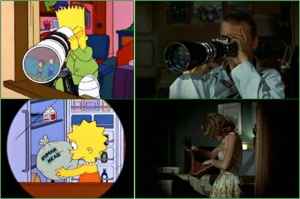
But the Simpsons ‘ most significant reference to Hitchcock is the reprise of Psycho. In Itchy & Scratchy & Marge (S2Ep9), Maggie attacks Homer in the same way as Norman Bates kills Marion Creigh. Homer clings to the shower curtain. Paint/blood spreads all over the bathtub. An extreme close-up on Homer’s eye conveys the same deadly terror as Janet Leigh, followed by a cut on his static face, lying lifeless on the ground. In Marge in Chains (S4Ep21), we follow Maud Flanders inside a hall decorated with stuffed birds. Shot by shot, we see her stare at a painting, then at a mysterious light through a hole in the wall, the camera getting closer to her spying eye, exactly like Norman. The same shot-to-shot process is used in Black Widower (S3Ep21), where Sideshow Bob discovers Bart sitting on a chair just as Lila Crane comes face to face with Mrs. Bates’ corpse. Furthermore, Bates’ house and motel have often been used as sets for several Treehouses of Horror. Lastly, in Who Shot Mr. Burns? part 1 (S6Ep25), thoughts of Mr. Burns haunt Homer while he is driving, just as Marion’s guilt awakens in the long driving sequence where the camera focuses on the emotional variations of her face.
Walt Disney
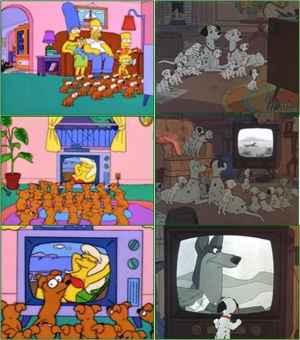 The Simpsons has often cited One Hundred and One Dalmatians as a major source of inspiration. It is this film that has led Groening towards the cartoon path, thus it is natural to find many references to Disney masterpieces in the show. Two Dozen and One Greyhounds (S6Ep20) is an obvious pastiche of 101 Dalmatians: Mr. Burns takes on the role of Cruella de Vil, Santa Little Helper replaces Pongo, and Nanny is authentically reproduced, the only difference being her yellow colour which automatically assimilates her to a Springfield character.
The Simpsons has often cited One Hundred and One Dalmatians as a major source of inspiration. It is this film that has led Groening towards the cartoon path, thus it is natural to find many references to Disney masterpieces in the show. Two Dozen and One Greyhounds (S6Ep20) is an obvious pastiche of 101 Dalmatians: Mr. Burns takes on the role of Cruella de Vil, Santa Little Helper replaces Pongo, and Nanny is authentically reproduced, the only difference being her yellow colour which automatically assimilates her to a Springfield character.
Mypods and Boomsticks (S20Ep7) incorporates the famous flying carpet scene in Aladdin, where our beloved Genie makes a memorable appearance. The performance of Dan Castellaneta, the original voice of the Genie in the Aladdin television series, makes the parallel even more significant . Homer has a nightmare where the Genie – who is able to transform himself and, like the original version, mimic Jack Nicholson’ s traits – turns Homer’s America, the ‘decadent, Western society’, into a stereotypical Islāmic republic. Groening makes fun of the widespread Islamophobia that defines Western opinions and generates distaste for, and fear of, Muslim culture. He also criticises our vision of Islam, conditioned by popular culture – what Said calls ‘Orientalism’ – , often irrelevant and far from reality.
When we refer to The Lady and The Tramp, we instantly think about that romantic scene where the two dogs share pastas and, involuntarily, by absolute coincidence, end up kissing each other. Since then, it has become the perfect romantic plan, almost a cinematic institution. At least six Simpsons episodes caricature this famous scene. In Two Dozen and One Greyhounds (S6Ep20), Santa Little Helper and She’s the Fastest kiss by magic while they share the same pastas, in a similar set up, with similar colours and light. The same goes on with Mr. Burns and Gloria (Hunka Hunka Burns in Love, S13Ep4), Homer and Mindy (The Last Temptation of Homer, S5Ep9), Bart and Darcy (Little Big Girl, S18Ep12) and naturally, Marge-Lady and Homer-Tramp in “Shady and The Vamp” (Love, Springfieldian Style, S19Ep12). Many more episodes are worth looking at in details and offer enjoyable imitations of our favourite Disney films. For instance, a number of them parodies The Lion King, a classic. Pinocchio has his own doppelganger in Krusty gets Kancelled (S4Ep22), and in Homer, Badman (S6Ep9), Homer escapes his problems by imagining living under the sea, a noticeable pastiche of Sebastian’s song in The Little Mermaid.
Simpsoncalifragilisticexpiala(Annoyed Grunt)cious (S8Ep13), a pure parody of Mary Poppins, presents a biting critique of the 1950s films that delivered an 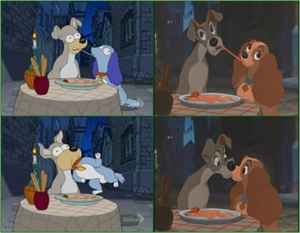 idealistic vision of American families. Discipline, obedience and order were at the basis of the perfect domestic sphere, a cliché completely deconstructed by the Simpson family. The last song praises the family’s imperfection, each member claiming they are all ‘happy, just the way they are’. Matt Groening demonstrates that this type of education is now impossible as times have changed, and children are not as innocent as little Michael and Jane Banks. Shary Bobbins herself is very different from the original one: she teaches Bart and Lisa to hide their dirty things under the bed instead of properly cleaning them, in ‘the American way’. She sings about drunkards on the street and becomes an alcoholic herself. The use of a new range of imagery and metaphors creates unusual, non-poetic but somehow catchy musical scores. In the satirical Simpsons show, the family institution has degenerated, and we are far from the utopian society described in the Disney films…
idealistic vision of American families. Discipline, obedience and order were at the basis of the perfect domestic sphere, a cliché completely deconstructed by the Simpson family. The last song praises the family’s imperfection, each member claiming they are all ‘happy, just the way they are’. Matt Groening demonstrates that this type of education is now impossible as times have changed, and children are not as innocent as little Michael and Jane Banks. Shary Bobbins herself is very different from the original one: she teaches Bart and Lisa to hide their dirty things under the bed instead of properly cleaning them, in ‘the American way’. She sings about drunkards on the street and becomes an alcoholic herself. The use of a new range of imagery and metaphors creates unusual, non-poetic but somehow catchy musical scores. In the satirical Simpsons show, the family institution has degenerated, and we are far from the utopian society described in the Disney films…
Quentin Tarantino
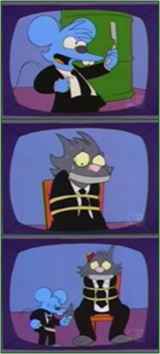 The purpose of Tarantino’s overuse of violence is to make us laugh. He satirizes the need for destruction, deeply anchored in men’s hearts, and criticises the cult of materialism and ‘coolness’. Reservoir Cats is an Itchy and Scratchy episode (Simpsoncalifragilisticexpiala(Annoyed Grunt)cious (S8Ep13)) which replicates the famous scene in Reservoir Dogs where Mr. Blonde cuts Marvin Nash’s ear. The cat and the mouse wear black suits, just like Tarantino’s characters, and the shots’ combination is practically the same as in the film. Like the director, Itchy and Scratchy point out how extreme violence is subject to human fascination (and children’s amazement), in an unhealthy and morbid way. At the end of the episode, Tarantino appears and addresses the audience: ‘What I’m trying to say is that violence is everywhere, man, it’s like even in breakfast cereals man’. But Itchy interrupts him, chops his head off and dances around his decapitated body, a parallel to Pulp Fiction‘ s dance scene. Violence reigns where words fail…
The purpose of Tarantino’s overuse of violence is to make us laugh. He satirizes the need for destruction, deeply anchored in men’s hearts, and criticises the cult of materialism and ‘coolness’. Reservoir Cats is an Itchy and Scratchy episode (Simpsoncalifragilisticexpiala(Annoyed Grunt)cious (S8Ep13)) which replicates the famous scene in Reservoir Dogs where Mr. Blonde cuts Marvin Nash’s ear. The cat and the mouse wear black suits, just like Tarantino’s characters, and the shots’ combination is practically the same as in the film. Like the director, Itchy and Scratchy point out how extreme violence is subject to human fascination (and children’s amazement), in an unhealthy and morbid way. At the end of the episode, Tarantino appears and addresses the audience: ‘What I’m trying to say is that violence is everywhere, man, it’s like even in breakfast cereals man’. But Itchy interrupts him, chops his head off and dances around his decapitated body, a parallel to Pulp Fiction‘ s dance scene. Violence reigns where words fail…
In a special episode, 22 Short Films about Springfield (S7Ep21), Chief Wiggum and Snake are the protagonists of a Pulp Fiction remake. Snake incarnates Bruce Willis’s character, who runs down a man with his car, drives like a maniac to escape the police, hides in an alley behind a wall and fights in a shop with his pursuer before the owner menaces them with his rifle. In another scene, we can see the policemen eating in a fast food, an exact replica of the restaurant at the beginning of the film. They talk about the differences between McDonalds and Krusty Burger, just as Vincent and Jules discuss the variations between a European and an American McDonalds. Hence we can see the similarities between Tarantino’s work and The Simpsons as both criticize a society gone mad, obsessed with consumerism, and insensitive to brutality.
Martin Scorsese
Scorsese’s work addresses a variety of crucial themes with much audacity, themes such as redemption and guilt, notions of good and evil, violence and decadence. He explores the human soul and the darker side of man’s actions, and elaborates a complex social critique of our times. His characters are often criminals, or gain money out of violence (Raging Bull tells us about the life of Jake LaMotta, a boxer). For the portrayal of Springfield’s mafia, The Simpsons reproduces the mimics, traits and accents of Scorsese’s protagonists, reduced to the Italian criminal cliché. Fat Tony and his gang are important characters in Springfield and appear in many episodes. Introduced to the audience for the first time in Bart The Murderer (S3Ep4), the episode follows the storyline of Goodfellas as Bart becomes part of the city’s local mafia and gets involved in cigarette smuggling. He comes home with a brand new suit and a number of cigarette boxes, piled in his room. Paul Sorvino inspires the character of Fat Tony, and Louie resembles Joe Pesci. In his dream, Bart discovers Skinner’s body inside a cold room, which parallels Frankie Carbone’s death in the film.
Duffless (S4Ep16) and Treehouse of Horror XI (S12Ep1) reproduce the violence of the car scene with Joe Pesci and Frank Vincent in Raging Bull, where both victims -Barney in the first one and the comic book owner in the second one – are savagely hit on the head with the car door. In The Homer They Fall (S8Ep3), boxing is the central theme, and the black and white sequence of Homer winning one fight after the other, with the inscriptions of the names of his opponents in between, is a direct innuendo to Raging Bull‘ s aesthetic. Other important references to Scorsese’s films include Moe trying his new gun in front of the mirror while repeating ‘Are you talkin’ to me?’ in Burns’ Heir (S5Ep18), like Travis in Taxi Driver, and The Debarted (S19Ep13), obviously based on The Departed ‘s storyline.
Steven Spielberg
An endearing alien, a touching child-robot, ferocious dinosaurs, a fake pilot, a bunch of soldiers 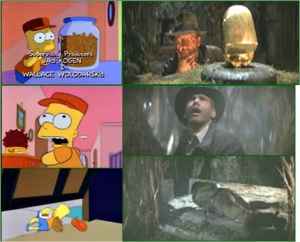 from World War II, pitiless sharks…and the list goes on. Spielberg’s contribution to the film industry is colossal; he has inspired new generations of artists and has nurtured children’s fantasies and imaginations across the world. No wonder why The Simpsons have so often reused his shots and imitated scenes from his movies. In A Star is Burns (S6Ep18), Mr. Burns wants to make a movie and asks for Spielberg, but since the director cannot come, he hires his Mexican doppelgänger, Spielbergo. The episode refers to many cinematic masterpieces, and includes the last scene of E.T, Burns playing the little extraterrestrial going back home. In Treehouse of Horror XVIII (S19Ep1), Bart plays Elliot and E.T is incarnated by Kodos, the dangerous Simpson alien.
from World War II, pitiless sharks…and the list goes on. Spielberg’s contribution to the film industry is colossal; he has inspired new generations of artists and has nurtured children’s fantasies and imaginations across the world. No wonder why The Simpsons have so often reused his shots and imitated scenes from his movies. In A Star is Burns (S6Ep18), Mr. Burns wants to make a movie and asks for Spielberg, but since the director cannot come, he hires his Mexican doppelgänger, Spielbergo. The episode refers to many cinematic masterpieces, and includes the last scene of E.T, Burns playing the little extraterrestrial going back home. In Treehouse of Horror XVIII (S19Ep1), Bart plays Elliot and E.T is incarnated by Kodos, the dangerous Simpson alien.
Some episodes like Itchy and Scratchy land, Homer Goes to College (S5Ep3) or Old-Yeller Belly (S19Ep14) pay tribute to Jaws, like when Homer and Bart swim in the sea with fake shark fins on their back to scare tourists, or when Bart slips his fingers on the blackboard to require attention, like Quint in the film. A whole sequence of Treehouse of Horror XVI (S17Ep1) replicates the story of Artificial Intelligence. In Homie The Clown (S6Ep15), Homer sculpts a circus tent out of mashed potatoes, just like Roy Neary builds the Devil’s Tower in front of his disconcerted family in Close Encounter of the Third Type.In Bart’s Friend Falls in Love (S3Ep23), a whole sequence of shot is taken from the first Indiana Jones, where the hero grabs the golden statue from the cavern. Here, Bart faithfully replicates Harrison Ford’s facial expressions and his movements towards the treasure (Homer’s jar of coins). He runs for his life, jumping over the cat like Indy jumps over a crevice, rolling under the parking gate like Indy rolls towards the exit, without forgetting his hat. In Catch’em If You Can (S15Ep18), the credits at the beginning parody the famous musical montage at the start of Catch Me If You Can, and we recognize the same style of drawings, with elegant, black silhouettes of pilots and stewardesses on a blue background.
Several episodes alludes to Jurassik Park. In Bart Gets an Elephant (S5Ep1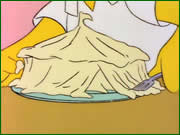 7) and 30 Minutes Over Tokyo (S10Ep23), an enormous eye stares at Marge/Lisa just as the dinosaur looks upon the frightened Murphy children. In When You Dish Upon A Star (S10Ep5), a glass of strawberry milk starts to vibrate frenetically when a crowd of Springfield citizens rushes to greet the two big stars Kim Basinger and Alec Baldwin, an allusion to the glass of water in the car announcing the arrival of the T-Rex. Lastly, E-I-E-I (Annoyed Grunt) (S11Ep5) imitates a whole range of shots from Saving Private Ryan, when the soldiers arrive on the French beach. But it ends differently: the dead bodies wake up, face the camera with a can of Buzz Cola in their hands and smile. Yes, the battle scene serves a commercial purpose. The audience laughs sarcastically, almost uncomfortably, as the sitcom reshapes the scene to illustrate society’s imprisonment within the advertising world, under the reign of TV and massive consumerism. Groening wants to show how far society can go to sell; as far as using violence and history to push people towards buying.
7) and 30 Minutes Over Tokyo (S10Ep23), an enormous eye stares at Marge/Lisa just as the dinosaur looks upon the frightened Murphy children. In When You Dish Upon A Star (S10Ep5), a glass of strawberry milk starts to vibrate frenetically when a crowd of Springfield citizens rushes to greet the two big stars Kim Basinger and Alec Baldwin, an allusion to the glass of water in the car announcing the arrival of the T-Rex. Lastly, E-I-E-I (Annoyed Grunt) (S11Ep5) imitates a whole range of shots from Saving Private Ryan, when the soldiers arrive on the French beach. But it ends differently: the dead bodies wake up, face the camera with a can of Buzz Cola in their hands and smile. Yes, the battle scene serves a commercial purpose. The audience laughs sarcastically, almost uncomfortably, as the sitcom reshapes the scene to illustrate society’s imprisonment within the advertising world, under the reign of TV and massive consumerism. Groening wants to show how far society can go to sell; as far as using violence and history to push people towards buying.
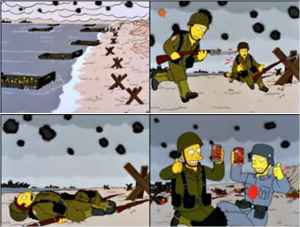
The Simpsons is deeply anchored in the cinematic tradition, and is a precious resource of film references. A number of famous guests, from actors to directors, have participated in the making of some episodes, which ties the show even more to the film industry. Those allusions to popular culture serve the satirical message of the show, and makes its social criticism more vivid and understandable to the audience. By using and diverting well-known references, the spectator identifies with the Simpsons’ portrayal of society. If he feels connected to it in some way, then he realises he is part of that system. Through our favourite cinematic moments, Groening presents us with a solidly built critique which sharpens our consciousness; just like cinema raises awareness about the world that surrounds us and about the issues that stem from our contemporary society.
What do you think? Leave a comment.
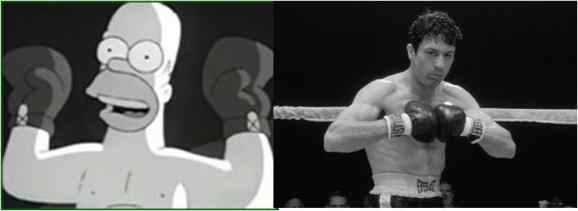
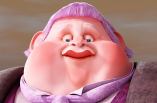

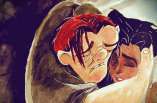








When The Simpsons was in its golden period it was amazing. The episode Cape Fear with Sideshow Bob is probably the best episode of the show.
I love this episode!
I don’t think one can logically conclude you’re a famous part of American pop culture until you’ve been officially “Simpsoned” in an episode or movie. Is there anything or anyone important in America that show hasn’t parodied, satired or skewered?
I agree 🙂
The character development was worn thin by season 10, everything after lost the charm. The characters lost all identity. Father, son, friend, student, kid all that, they just became differently shaped, differently voiced, wacky machines here to keep pumping out that cash cow.
The characters used to have depth, not just one wacky adventure featuring X celebrity cameo each week. That show is dead to me.
Simpsons was considered “edgy” and “innovative” in its early days. However, after season 9/10ish, the show lost its subtlety, and relied on more physical, outrageous plot elements, or rehashing of familiar concepts for jokes. It featured more and more frivolous celebrity appearances. The jokes became more and more cringeworthy. It’s not that there aren’t any good episodes since then, but the majority of them were “blah”. Few of those make catchphrases in popular culture now, while everyone in their mid 20s or older can remember a “Lisa needs braces… dental plan!”
Of course, the “edgy” sector was taken over by South Park, Futurama, and Family Guy, and these shows have had their ups and downs too. It’s not that the show is really “bad” per se, but it’s not as great as it was once upon a time. It set the bar too high for itself, basically.
I agree completely with your points, and I regret the times when the Simpsons were at their best. I feel like every good TV show reaches a point where the creators rely on their past success and run out of inspiration. It has nearly become an institution nowadays…
Around season 13 the show lost two minutes of run time which heavily impacts episode structure – eliminates a ton of non sequitors – and that’s right about when Al Jean took the show back over and he’s been running it since. He did an episode about Dennis Leary’s cellphone, that’s pretty close to the jokes made earlier in the run about when it would be time to cancel the show.
Love then one when homer’s whistling in the RV related to the Sound of Music?
Some references were dead on. 2001, Clockwork Orange, Vertigo, to name a few.
That Close Encounters of the Third Kind mashed potato scene is my favorite of all time.
très fier de toi ma Rachel!!
je pense a toi de Paris bisoux bisouxxx
Barbara
Ahhh merci beaucoup, ca me fait plaisir!
Je pense a toi aussi gros gros bisous
The best thing that ever happened to my life was defying my parents as a kid and watching the Simpsons….I have a Simpsons reference for every situation.
The Simpson’s is, indeed, much more intelligent than many people imagine. Groening uses so many film and TV references. He even references a lot of Scandinavian, Italian, French, and German films. One cannot watch The Simpsons without being inundated with film history. This is a great article and must have taken you a lot of time to research and write.
Thank you and glad you enjoyed it! Yes, of course, the references are not limited to Hollywood cinema, which makes the show even richer.
There are a couple shows where I feel like I can’t consider myself a true television “buff” until I’ve watched them. The Simpsons is one of them. I think that the fact that it has so many pop culture references over the span of it’s 25 seasons is such an example of it’s impact. It is a pop culture icon in itself now and it’s become so much more than just a cartoon or an animated sitcom. I commend it and can only hope to leave an impact like it one day.
The Simpsons is such a renowned show because its fantasy is also seemingly very real. There is a way; possibly through individual characters, or whole episode plots, that everyone can relate to the show. It’s the tale of an ordinary family that does extra-ordinary things. The plot of the Simpsons may even embody aspects of the american dream, bringing it down to simple, light-hearted humour.
It is disappointing to watch a once “daring”, “down to the nitty gritty,” show fall into the category of sitcoms nobody really watches anymore. I always found it rather annoying that writers would continue creating episodes for the sake of depositing another check, and focus less on the charm and wit the show originally provided. All good things must come to an end eventually.
That’s what I love about The Simpsons – it ties in movie references to its episodes which would seem like a cheap way to gain laughs, however, its more of a nod to classic cinematic moments that made Groening that man he is today.
I love the Simpsons! The lines are just genius. I’ll agree with a vast majority and say that it recent times it has lost some of its flavor, esp. with competition from shows like Family Guy, South Park, etc.
But I still get a good laugh from the Simpsons. Hopefully it’ll continue and if and when it does end, it’ll be with a bang.
A rising taste in television on the rise seems to be satirical comedies and news shows. With an ever increasing amount of news and information being broadcasted these days, people are looking for the most entertaining and effective way to get that news delivered. The busier our days get, the more we are inclined to sit back and watch shows like The Colbert Report and shows such as the The Simpsons that will not only relax us after a long day, but maybe even educate us on popular culture or current events.
Cultural satire is what makes Simpsons resonate with such a wide audience, but there is a definite change in the tone of the show once the seasons hit the double digits. Unlike “South Park,” “American Dad,” “Family Guy,” or any number of other animated shows, the satire of The Simpsons had a secondary purpose of displaying a “family-first” dynamic that is lost in the later seasons. The Simpson “Origin” episodes, in particular “And Maggie Makes Three” (S6Ep13), wherein by the close of an episode, we are left with a comment on how important caring for one’s family is, even at the expense of personal happiness (with the array of pictures of Maggie spread over the wall in Homer’s office, covering a dehumanizing plaque that, after being covered, reads “DO IT FOR HER”).
(TD;DR) I love the satirical and referential qualities of the Simpsons, and Bitoun’s critique pointed out so many wonderful moments from the show that I didn’t even know where there, but it seems that the show has lost its capacity to create touching moments in the quest to get as many laughs as fast as possible.
Thank you for your enlighting comment, I agree with pretty much everything you said. Sadly, and as many of you have pointed out, The Simpsons have changed, and it seems to have lost its emotional quality and its comic fierceness. Still, I am glad you’ve appreciated my article and discovered new references even in older episodes. And “And Maggie Makes Three” is one of my favourite episodes 🙂
I remember reading somewhere one of the creators of the show described the Simpsons as being “basically 2001: A Space Odyssey” mixed with something else…wish I could find the quote.
I allowed my family to watch “The Simpsons” despite the occasional four-letter word because there were always consequences to Bart’s or Homer’s antics. While I no longer tune in on a regular basis, I still catch an occasional show. Sometimes the new episodes lack the old spark, but sometimes they feel as fresh as the ones aired during the first few years it ran. You have to admit, it’s not easy to churn out show after show over so many years, and yet they’re still in the lineup.
I love this article. I was looking for something interesting on The Simpsons and hit the jackpot. thank you!
I recall that rather recently Canada and Justin Trudeau was spoofed.